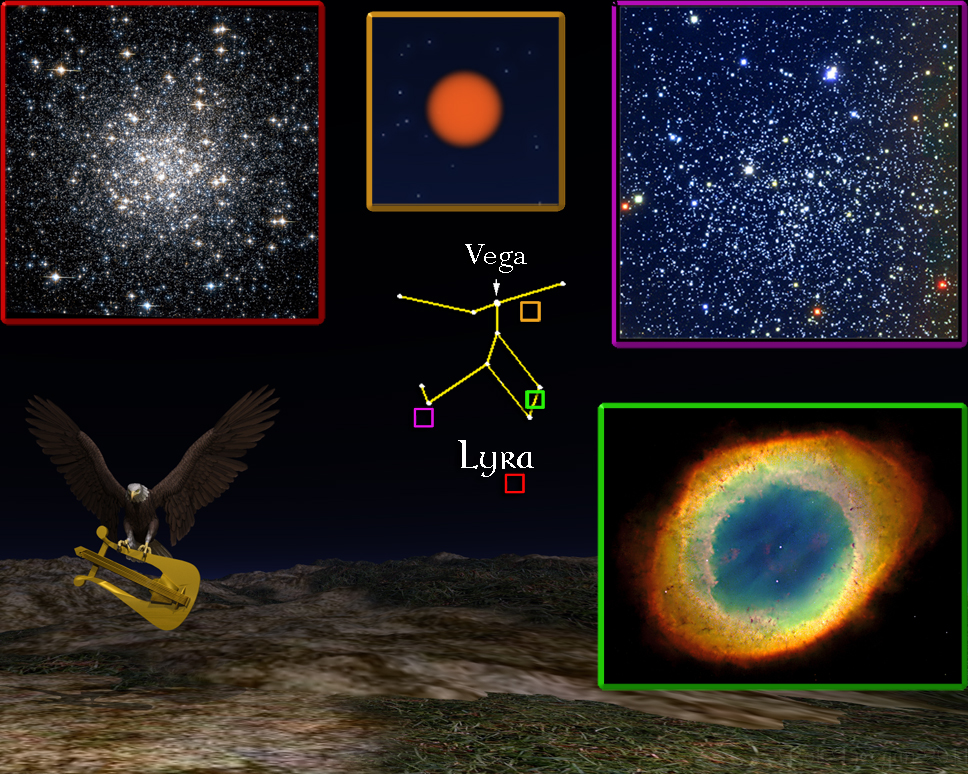
For the week including May 27, 2011

THE LYRE
Close to the eastern horizon around mid-evening you can see a conspicuously brilliant blue-white star. This is Vega in the constellation of Lyra, the Lyre or harp. The most popular legends about the Lyre, trace back to ancient Greece. Some say that this is the instrument used by Apollo, or maybe it’s the one invented by Hermes. There are lots of myths connected with this group of stars, but most people’s favorite is that it represents the magical lyre played by Orpheus. The adoption of the Lyre to represent this constellation was gradual. Ancient Arabic texts referred to these stars as a swooping eagle or vulture. So, on some star maps the constellation was called Aquila Cadens, or Vultur Cadens. Eventually there was Aquilaris, a blending of star tales featuring a swooping eagle carrying a lyre. But now it’s settled and the musical instrument stands alone in the sky. Although this constellation isn’t very large, it’s a favorite target for the telescopes of backyard astronomers:
The Ring Nebula (lower right): Through a fairly good telescope, the Ring Nebula looks like a gray-green smoke ring set among the stars.This “ghostly doughnut” is half a light year across, which is about 30,000 times the distance from the Earth to the Sun. The Hubble Space Telescope photo shows some of its finer details. Measurements have shown the Ring to be about 20,000 years old and expanding at the rate of twelve miles per second. The Ring formed from the outer layers of a dying star that exploded into space to form a glowing cloud or nebula. The small point just visible in the center of the ring is the white-dwarf remnant of the original star. At a distance of some 4,000 light years, it’s burning away at a high heat of 180,000 degrees Fahrenheit.
NGC 6791 (upper right): This is one of the oldest open clusters in our galaxy. The thousands of stars shown here are billions of years older than our Sun. Open star clusters condense out of clouds of gas situated in the galactic plane. Most of them gradually disperse, but NGC 6791’s members have remained gravitationally bound to each other.
M56 (upper left): A fine example of a globular cluster, M56 is 32,000 light years from us. Unlike open clusters, globular clusters form around the outside of a galaxy and generally contain its oldest stars. As the Hubble photograph shows, the cluster’s stars are not uniform in appearance which offers clues as to their ages and composition.
Individual stars of Lyra also reward investigation:
Vega is the fifth brightest star in the sky and takes its name from ancient Arabic for The Swooping Eagle, a designation they gave to the entire constellation. Vega, at almost thirty light years distant, is a convenient landmark for a spot called the “Solar Apex”, a location in space that our Sun is moving toward. This isn’t to say that anybody should watch to see if Vega gets bigger as we get closer. Since the Earth speeds along at only twelve miles-per-second, it’ll take us 450,000 years to reach the vicinity of Vega.
T Lyrae, shown in the illustration at upper center, isn’t visible without a small telescope, but is well worth searching for. This star, with its high carbon content, is one of the reddest visible from Earth. Its deep ruddy glow is quite striking against the black backdrop of space.
Photo credit for NGC 6791: Barbara J. Mochejska (CAMK) et al., 2.1-m Telescope, KPNO, NOAO, NSF
Unless otherwise indicated, all content of this web site is the copyright of Robert Deegan and all rights are reserved.
For more information, or to comment, please contact: Bob@NightSkies.org